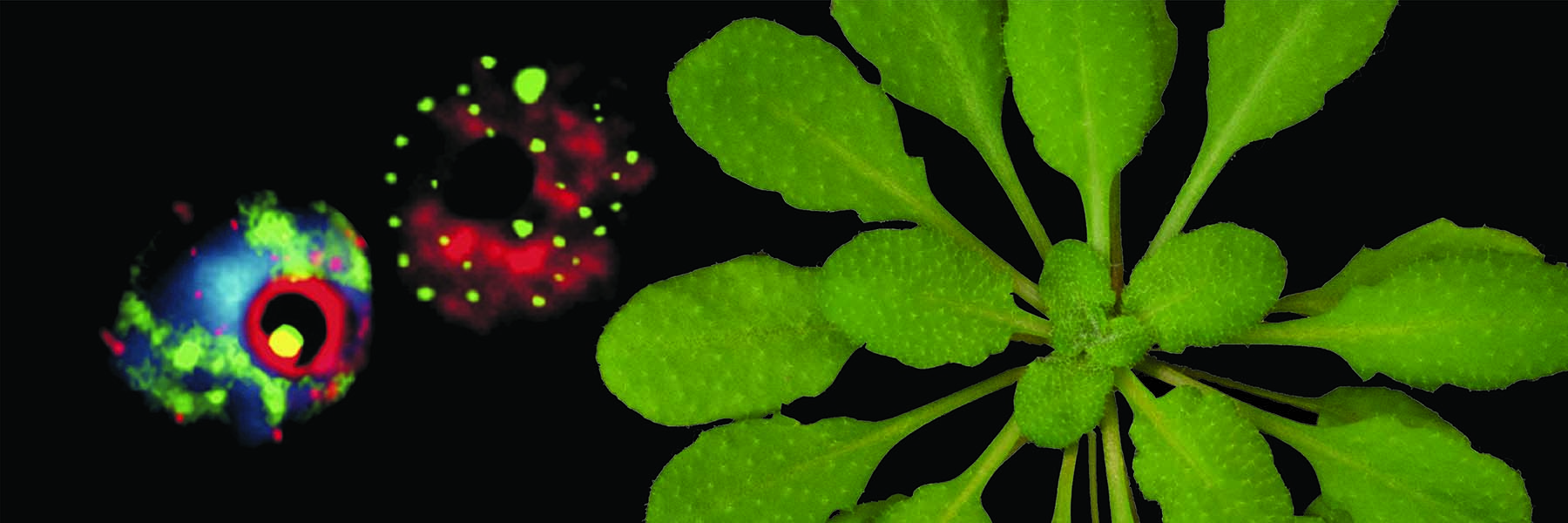In the Pikaard lab, we study how genes are turned on or off, using techniques of genetics, genomics, biochemistry, cell biology and molecular biology. Our current research projects are focused on the roles of chromatin modifying enzymes and noncoding RNAs in gene silencing and epigenetic phenomena.
An epigenetic phenomenon in which we are keenly interested is nucleolar dominance. This phenomenon was first discovered in genetic hybrids and describes the transcription, by RNA polymerase I, of ribosomal RNA genes inherited from only one of the progenitors. Importantly, the phenomenon also occurs in non-hybrids. In the case of our favorite non-hybrid model system, the Arabidopsis thaliana strain Col-0, fewer than half of the ~1800 rRNA genes present in diploid cells of leaves and other vegetative organs are expressed. We have shown that the molecular basis for nucleolar dominance is selective gene silencing, which targets specific sets of rRNA genes and occurs on a scale of millions of basepairs of chromosomal DNA. In fact, the scale of rRNA gene silencing is second only to the inactivation of one X-chromosome in somatic cells of female mammals, which is the basis for the random coat coloration of calico cats. But unlike X-inactivation, the choice of which set of rRNA genes to silence is not random, nor is it dictated by a maternal or paternal imprint. Genetic studies in our lab have shown that the A. thaliana Col-0 rRNA genes that are silenced during development are chosen primarily based on their chromosome affiliation, not their individual gene sequences. Specifically, the rRNA genes that are clustered within the ~5.4 million basepair (Mbp) nucleolus organizer region of chromosome 2 (NOR2) are mostly, but not entirely, silenced. By contrast, the genes localized within the ~3.9 Mbp NOR on chromosome 4, NOR4, are mostly, but not entirely, active. We are working to identify how the NORs are discriminated from one another in order to bring about NOR-specific rRNA gene regulation.
The second focus of the lab concerns multisubunit RNA polymerases IV and V (initially known as Pol IVa and Pol IVb) and their roles in RNA-directed DNA methylation. Pol IV and Pol V are plant-specific, DNA-dependent RNA polymerases that localize in the nucleus. We've shown that Pols IV and V each have 12 subunits, like DNA-dependent RNA polymerase II, and evolved as specialized forms of Pol II that only sysnthesize noncoding RNAs (RNAs that do not encode proteins). In the RNA-directed DNA methylation pathway, we have shown that Pol IV functions in a complex with RNA-dependent RNA Polymerase 2 (RDR2) to synthesize the double-stranded RNA precursors of 24 nt small interfering RNAs (siRNAs). These siRNAs then associate with an Argonaute family protein (primarily AGO4) and direct the silencing of transposons and other repeated sequences in the genome by interacting with long noncoding RNAs synthesized by Pol V. The siRNA-AGO complexes then guide DNA methylation and chromatin modifying enzymes to the adjacent chromosomal intervals, bringing about changes that repress gene activity. Our current efforts are focused on understanding precisely how these enzymatic reactions and chemical changes take place.
Where we are located: The Pikaard laboratory is located in Room 300 of Myers Hall, which is located on the beautiful, park-like campus of Indiana University, in Bloomington, Indiana
Affiliations: Craig Pikaard is an Investigator of the Howard Hughes Medical Institute and is a Distinguished Professor and the Carlos O. MIller Professor of Plant Growth and Development in the Department of Biology and the Department of Molecular & Cellular Biochemistry at Indiana University Bloomington (IUB).
Our Funding: The Pikaard lab's research is primarily supported by the Howard Hughes Medical Institute. Additional funding associated with the Carlos O. Miller endowed professorship is provided by IUB. Any materials or opinions expressed at this site are those of the author(s) and do not necessaily reflect the views of our sponsors.


